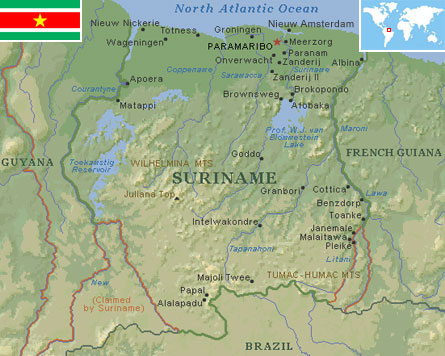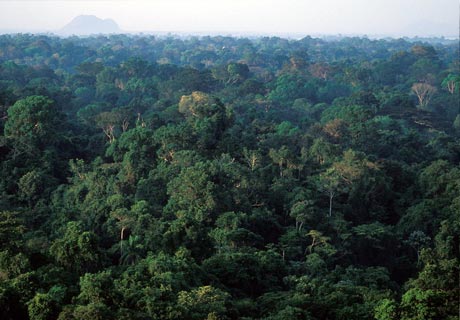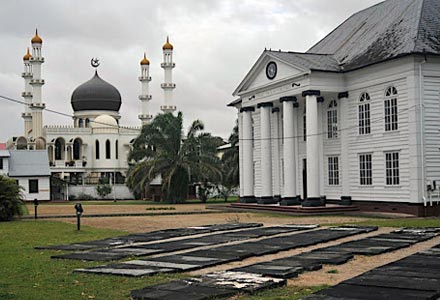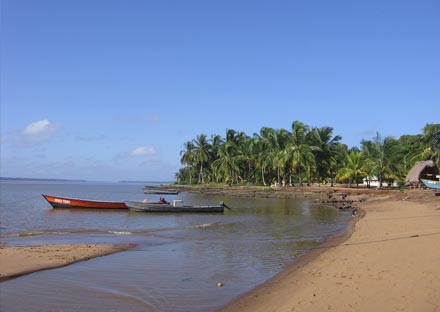Suriname
Country statistics

Land area: 62,344 sq miles (161,471 sq km)
Total area: 63,039 sq miles (163,270 sq km)
Population (2010 est.): 486,618 (growth rate: 1.1%); birth rate: 16.6/1000; infant mortality rate: 18.2/1000; life expectancy: 73.9; density per sq miles: 8
Capital City: Paramaribo
Monetary unit: Surinamese dollar
Languages: Dutch (official), Surinamese (lingua franca), English widely spoken, Hindustani, Javanese
Ethnicity/race: East Indians (Hindustanis) 37%, Creole (mixed white and black) 31%, Javanese 15%, "Bush Negroes" (also known as Maroons) 10%, Amerindian 2%, Chinese 2%, white 1%, other 2%
Religions: Hindu 27.4%, Protestant 25.2% (predominantly Moravian), Roman Catholic 22.8%, Islam 19.6%, indigenous 5%
Country introduction

Suriname is a country in northern South America. It borders French Guiana to the east, Guyana to the west, Brazil to the south, and the Atlantic Ocean to the north.
The country is mostly covered by the Amazon Rainforest, that contains a great diversity of flora and fauna which, for the most part, is increasingly being threatened by new development. The tropical rainforest is located in the south along with sparsely inhabited savannahs that run by the border of Brazil and covers about 80% of Suriname's land surface.
A relatively small population live in the north, most along the coast. The coastal plains covers about 16% of the country and largely consists of swampland, since most of this area lies near sea level. Some of these swamps have been drained to make land available for farming.
There are two main mountain ranges, the Bakhuys Mountains and the Van Asch Van Wijck Mountains. Julianatop is the highest mountain in the country at 1,286 m (4,219 ft) above sea level. Other mountains include Tafelberg at 1,026 m (3,366 ft), Mount Kasikasima at 718 m (2,356 ft), Goliathberg at 358 m (1,175 ft) and Voltzberg at 240 m (790 ft).
The principal rivers are the Corantijn river on the Guyana border, the Marowijne river on the French Guyana border, and in the middle the Suriname river on which the capital city of Paramaribo (also the largest city) with its 120,000 inhabitants is situated.
The culture

The Suriname culture is very dynamic and diverse and has a heavy Asian and African influence. People can be found from India, Africa, China and Indonesia as well as people who inhibited Suriname before it was discovered and populated. In fact, 90% percent of the people living in Suriname have ancestors who were foreign born. It is not uncommon to walk down any street in the city and not hear Dutch, Indian or English spoken. Even with a high diversity of culture and religions, people still remain tolerant and live peacefully among each other.
Having a lot of indigenous tribes in the country, numerous customs and traditions are followed. One of them is to serve huge amounts of food during birthdays and weddings, particularly if it is the jubilee celebration. Another tradition is to serve ritual meals called slametans during important life occasions. There are many festivals that are celebrated in the country by a majority of the population. The most common festivals include New Year's Day, Holi Phagwa, Labor Day, Keti Koti or Emancipation Day, Indigenous People's Day, New Year's Eve, Easter and Christmas. It is advised to visit the country during these days as it is very festive and sure to be a memorable experience.
The music in Suriname has been influenced by all parts of the world. While some traditional dances of the Amerindians remain, Surinamese dance and music have been largely influenced through the passage of time. Firstly, slavery brought several different traditional (West) African dances and music styles to Suriname. After slavery was abolished, different migrant workers from India and Indonesia brought along their own dancing rituals. Along with further migration, Surinamese dance has also been influenced by the Chinese, Lebanese and several European cultures.
The impact of various cultures can be seen in Suriname's cuisines and usually include rice, groundnuts, cassava fruits such as tayer (Creole), and roti (Hindi). Usually, on the menu there is chicken cooked in various forms and a speciality is a dish called bakkeljauw, which is cod fish made into balls. Beans, okra, and boulanger are examples of vegetables used in the Surinamese kitchen. Moksi alesi and the original Javanese fried rice and noodles are the most famous dishes of Suriname.
Attractions & landmarks

A number of Suriname's historical landmarks are in the capital city of Paramaribo, a city characterised by the well preserved Dutch colonial street plans and a distinctive blend of Dutch architecture. The oldest landmark located here is indisputably the ancient Cathedral of St. Peter and Paul, which was built from 1883 to 1885. The cathedral has 18 confession rooms and can accommodate up to 340 people. Another famous landmark is the Ahmadiyya Anjuman Isha'at Mosque, which was the first mosque completed in 1932 and was created as a wooden rectangular building with minarets. It was rebuilt in 1984 and today is considered the largest mosque in the Caribbean. Located next to this mosque is the Neveh Shalom Synagogue, a Jewish place of worship constructed in 1719. Both the Synagogue and the Mosque function so amicably that during certain festivals pertaining to their respective religions (sometimes even coinciding), these religious places of worship share their parking lot, providing an excellent example of their religious tolerance.
The Amazon Rainforest covers most of the Suriname surface and is home to thousands of birds, reptiles, monkeys and even a handful of jaguars. Due to the vast natural lands and the diversity of flora and fauna within them, almost a third of the country is declared a national reserve and as a result has become the main tourist attraction. The Central Suriname Nature Reserve is the biggest and one of the most popular reserves in Suriname. Its 16,000 sq km (6,178 sq miles) of land covers a range of topography and ecosystems of notable conservation value due to its pristine state. Its montane and lowland forests contain a high diversity of plant life with more than 5,000 vascular plant species collected to date. The Reserve's animals are typical of the region and include the jaguar, giant armadillo, giant river otter, tapir, sloths, 8 species of primates and 400 bird species such as harpy eagle, Guiana cock-of-the-rock, and scarlet macaw. Another popular reserve is the Brownsberg Nature Park which is home to one of the largest man-made lakes in the world, the Brokopondo Reservoir.
The village of Galibi is a great place to visit and can be reached by boat from the town of Albina. The main reason tourists visit Galibi is to witness the impressive breeding process of large leatherback sea turtles, which come from all over the world to lay their eggs including places as distant as Costa Rica and Australia. Galibi is also a fishing village and 80% of the population live from fishing.